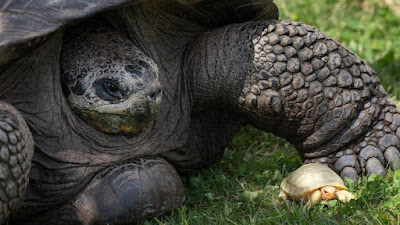The odds of an albino giant tortoise are 1 in 100,000.
 |
| Tiny white tortoise baby is the "first of its kind" |
An extremely rare white tortoise baby has just been revealed to the world for the very first time. The tiny, red-eyed reptile has pigmentless skin and a pale shell, caused by a genetic disorder known as albinism. Zoo keepers say the odds of an albino tortoise are 1 in 100,000.
The white tortoise is one of two Galápagos giant tortoises (Chelonoidis niger) that recently hatched at Tropiquarium, a zoo in Servion, Switzerland. The pair of eggs were laid by a 220-pound (100 kilograms) female on Feb. 11; the albino baby hatched on May 1 and its darker sibling emerged on May 5. The baby tortoises each weighed just 1.8 ounces (50 grams) at birth and were initially hand-reared by zookeepers in incubators, before rejoining their mother at the zoo on June 3, according to Reuters.
"We were surprised to discover an albino baby," zoo staff wrote in a statement. "This is the first time in the world that an albino Galápagos tortoise has been born and kept in captivity," and there are no documented cases in the wild, they added. The team also speculated that the birth of a white tortoise could be as much as five times rarer than the birth of an albino human, which is around 1 in 20,000 people, according to the National Organization for Albinism and Hypopigmentation, a nonprofit organization that provides information and resources about albinism to people in the U.S. and Canada.
Albinism is a genetic condition, which means it is passed down from parents to offspring. However, it is a recessive trait, so both parents need to possess and pass on a copy of the gene. Because the parents usually only have one copy of the albino gene (unless they are also albino), they appear with the animal’s typical colors.
It is unclear how long the albino hatchling might survive. Galápagos giant tortoises are the largest tortoises on Earth and can live for more than 100 years in the wild. However, albinism can make animals more susceptible to damage from the sun's ultraviolet rays and prone to other health complications, such as reduced vision and hearing difficulties. It also makes animals that are normally darker colored more visible to predators. This means animals with albinism often don’t survive for very long and die before they can pass on their genes — which explains why the condition is so rare. But if they are cared for properly in captivity they can live relatively healthy lives.
source: Reuters
Tags:
Incredible
